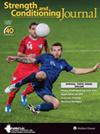竞技举重运动员下半身、多关节、等长和动态神经肌肉评估变量与抓举、挺举和挺举成绩的关系:Meta分析
IF 3
4区 医学
Q2 SPORT SCIENCES
引用次数: 2
摘要
摘要本荟萃分析的目的是综合文献,对竞技举重运动员的下半身、多关节、等长和动态神经肌肉评估变量与抓举(SN)和挺举(C&J)成绩之间的相关性进行稳健估计。通过对3个电子数据库(PubMed、SPORTDiscus和Web of Science)的全面搜索,返回了12项符合纳入标准的研究。对SN和C&J表现之间的Pearson相关性以及来自5种神经肌肉评估的15个变量进行了荟萃分析——反动作跳跃(CMJ)、深蹲跳跃(SJ)、等长中高提拉(IMTP)、后深蹲(BS)和前深蹲(FS)一次重复最大值(1RM)。FS和BS 1RM表现出近乎完美的相关性(r=0.93至0.94),而IMTP峰值力表现出非常大的相关性(r=0.83至0.85)。250ms时的IMTP力表现出很大的相关性(P=0.77至0.78),CMJ和SJ峰值功率呈现出非常大到几乎完全的相关性(r=0.88到0.92)。这些发现说明了举重运动员下半身最大和限时发力能力的重要性。此外,每项评估都至少提供一个相关性>0.70的变量。因此,这些评估可以用来衡量举重表现的潜力。本文章由计算机程序翻译,如有差异,请以英文原文为准。
The Relationship of Lower-Body, Multijoint, Isometric and Dynamic Neuromuscular Assessment Variables With Snatch, and Clean and Jerk Performance in Competitive Weightlifters: A Meta-Analysis
ABSTRACT The purpose of this meta-analysis was to synthesize the literature and provide a robust estimate of the correlations between lower-body, multijoint, isometric and dynamic neuromuscular assessment variables and snatch (SN) and clean and jerk (C&J) performance in competitive weightlifters. A comprehensive search through 3 electronic databases (PubMed, SPORTDiscus, and Web of Science) returned 12 studies that met the inclusion criteria. Meta-analyses were performed on Pearson's correlations between SN and C&J performance and 15 variables from 5 neuromuscular assessments—countermovement jump (CMJ), squat jump (SJ), isometric midthigh pull (IMTP), back squat (BS), and front squat (FS) one repetition maximum (1RM). The FS and BS 1RM exhibited nearly perfect correlations (r = 0.93 to 0.94), whereas the IMTP peak force exhibited very large correlations (r = 0.83 to 0.85). The IMTP force at 250 ms exhibited very large correlations (r = 0.77 to 0.78), and the CMJ and SJ peak power exhibited very large to nearly perfect correlations (r = 0.88 to 0.92). These findings illustrate the importance of lower-body maximal and time-limited force-producing capabilities in weightlifters. Moreover, each assessment offers at least one variable that exhibits a correlation of >0.70. Therefore, these assessments may be used to gauge weightlifting performance potential.
求助全文
通过发布文献求助,成功后即可免费获取论文全文。
去求助
来源期刊

Strength and Conditioning Journal
社会科学-运动科学
CiteScore
4.70
自引率
8.00%
发文量
49
审稿时长
6-12 weeks
期刊介绍:
Strength and Conditioning Journal is the professional journal for strength coaches, personal trainers, physical therapists, athletic trainers, and other health professionals working in the strength and conditioning field. The journal’s mission is to publish articles that report both the practical applications of research findings and the knowledge gained by experienced professionals.
 求助内容:
求助内容: 应助结果提醒方式:
应助结果提醒方式:


